Ensuring the safety and containment of our furry friends is a top priority for pet owners, and sometimes, standard fencing may fall short of meeting the specific needs of larger or more agile dogs. In this article, we will explore practical methods on how to make fence taller for dog, providing a comprehensive guide for pet owners seeking to enhance the security of their outdoor spaces.
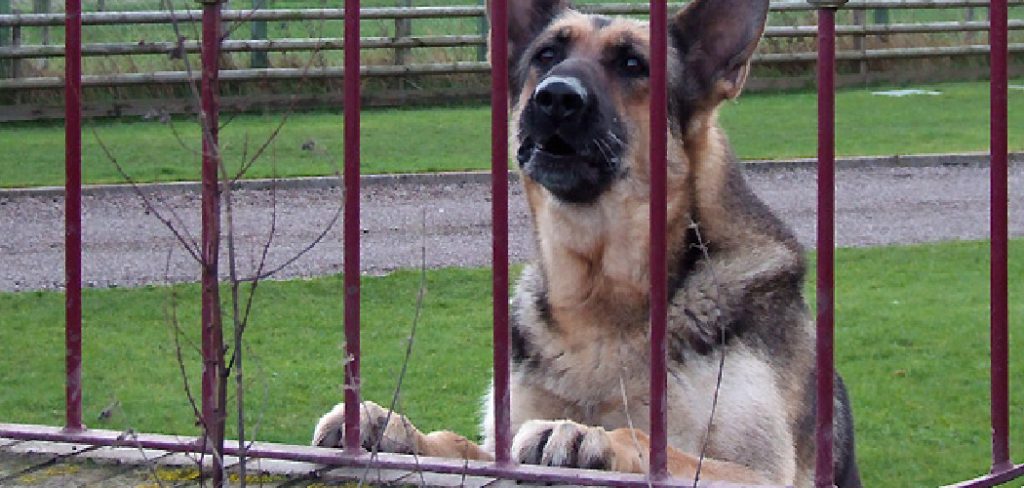
From choosing the right materials and evaluating the existing fence structure to implementing effective height-boosting techniques, this guide aims to empower dog owners with the knowledge needed to create a secure and pet-friendly environment. Join us on this informative journey as we delve into the methods that allow you to raise the height of your fence, ensuring the safety and well-being of your beloved canine companions.
The Importance of A Secure Fence for Containing Dogs
A secure fence serves as the first line of defense in safeguarding your dog within the confines of your property. Not only does it prevent your pet from wandering off and potentially getting lost or injured, but it also plays a crucial role in protecting them from external threats such as predators or aggressive animals. Additionally, a sturdy and tall fence can deter thieves or anyone who might attempt to harm or steal your pet.
Beyond safety, a well-built fence provides a sense of freedom for your dog, allowing them to explore, play, and exercise within a controlled environment, thereby enhancing their quality of life without compromising their security. Therefore, ensuring the fence is adequately tall and secure is paramount for any responsible pet owner.
Reasons Why Fence for Dogs May Need to Increase
Several factors may necessitate the need to increase the height of a fence for dogs, ensuring their safety and security. Firstly, the breed and size of the dog play a significant role; larger breeds or those with a strong jumping ability may easily overcome standard fence heights. Secondly, dogs with high energy levels or those prone to anxiety might attempt to escape as a way to release pent-up energy or due to fear, respectively.
External stimuli such as neighboring pets, wildlife, or pedestrians can also trigger a dog’s instinct to chase or investigate, prompting them to leap over fences that are too low.
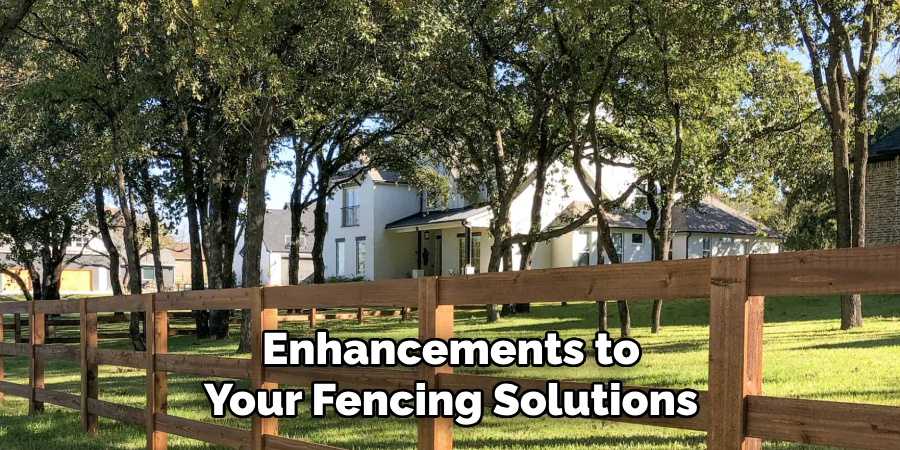
Additionally, the introduction of new regulations or changes in local wildlife activity might require enhancements to your fencing solutions. Understanding and addressing these factors is crucial for creating a secure and escape-proof outdoor space for your canine companion.
Understanding Dog Jumping Behavior
A pivotal aspect in effectively increasing the height of your fence involves understanding dog jumping behavior. Dogs may attempt to jump fences for a myriad of reasons, including the innate desire to explore beyond their immediate surroundings, pursuit of an animal or an interesting object, or even social isolation and seeking attention.
Recognizing that jumping can be both a natural instinct and a learned behavior is key. Some dogs learn that by jumping, they gain access to greater freedom or attention from their owners upon return. Additionally, specific breeds are more predisposed to leaping due to their physical capabilities and historical breeding purposes.
Addressing the root cause of jumping, whether it’s lack of exercise, curiosity, or separation anxiety, is essential in devising a comprehensive strategy to make your fence more secure. Understanding your dog’s motivation for jumping is the first step in preventing these behaviors and ensuring their safety within your property boundaries.
Factors Influencing Dogs to Jump or Climb Fences
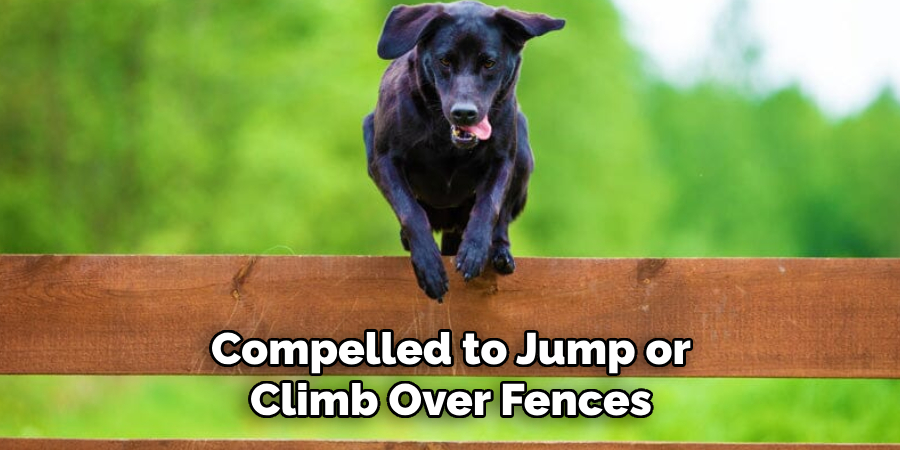
There are several reasons why dogs may feel compelled to jump or climb over fences, ranging from psychological motivations to environmental stimuli. A primary cause is the natural instinct of dogs to roam and explore their surroundings, which can lead to attempts at escaping confined spaces.
Additionally, loneliness or boredom can drive dogs to seek interaction or stimulation outside their immediate environment. Dogs that are left alone for extended periods without adequate mental or physical engagement may try to escape as a means of relieving their boredom or finding companionship.
Another significant factor is the presence of other animals, people, or objects that may catch a dog’s attention or provoke their hunting instincts. The sight or smell of something intriguing on the other side of the fence can be irresistible to a curious or excitable dog.
Separation anxiety also plays a role in why some dogs try to escape. They may attempt to reunite with their owners out of distress when left alone. Finally, insufficient exercise is a common culprit.
Dogs with a lot of pent-up energy are more likely to undertake such behaviors as jumping or climbing fences to discharge their excess energy. It’s crucial for pet owners to understand these motivations as they consider ways to adapt their fencing to better suit their dog’s needs and instincts.
Physical Capabilities of Different Dog Breeds
Different dog breeds possess varying physical capabilities, which can greatly influence their ability to overcome barriers such as fences. For example, breeds like the Greyhound and Whippet, known for their incredible speed and agility, also have a significant ability to leap high distances.

This is due to their strong hind leg muscles and lean build, allowing them to launch themselves over obstacles that would contain other breeds. On the other hand, breeds such as the Bulldog or Basset Hound, with their heavier bodies and shorter limbs, are less likely to be able to jump high fences but might attempt to use their strength to push through weaker barriers.
Additionally, breeds like the Border Collie or Australian Shepherd not only possess the physical capacity to jump high but also an intellectual curiosity and problem-solving skills that might lead them to find alternative ways to escape if they’re motivated enough. Understanding the unique physical and mental traits of different breeds is key to implementing effective measures to secure them within a property.
Potential Risks Associated with Insufficient Fence Height
Beyond breed-specific physical capabilities, factors such as age, health, and individual athleticism also play crucial roles in a dog’s ability to overcome physical barriers. Younger dogs, for instance, may have more energy and agility, pushing them to explore and possibly escape, while older dogs may lack the strength or interest in jumping over fences.
Health conditions can significantly impact a dog’s physical abilities as well; issues with joints or weight can hinder their ability to jump or climb.
Additionally, individual differences in athleticism can vary widely even within the same breed, making it essential for pet owners to assess their own dog’s capabilities and motivations. Understanding these variances is crucial in tailoring security measures to each pet’s specific needs, ensuring they are kept safe and secure within their environment.
10 Methods How to Make Fence Taller for Dog
1. Install Extendable Fence Toppers:
Extendable fence toppers are pre-made extensions that can be added to the existing fence to increase its height. These toppers are often made of durable materials such as metal or wood, providing a quick and straightforward solution to make the fence taller without significant reconstruction.
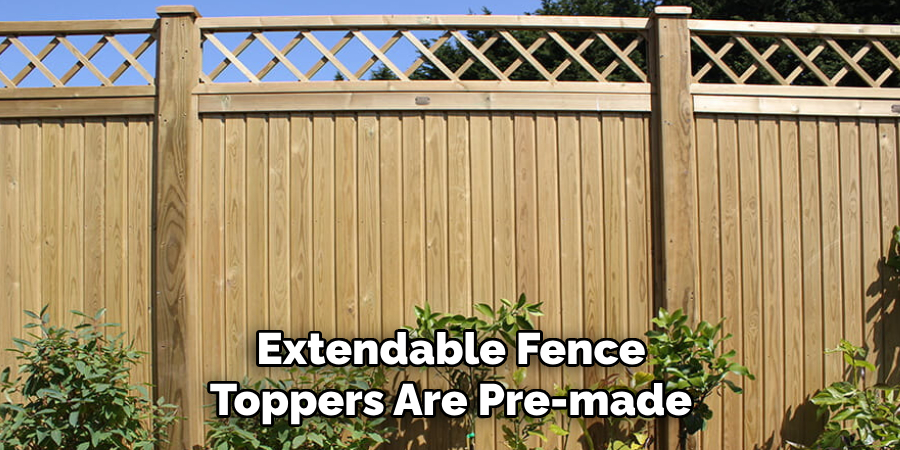
Adding extendable fence toppers can provide several benefits for your property. These include increased privacy, improved security, and enhanced aesthetics.
Privacy is an essential aspect for many homeowners, and installing extendable fence toppers can help achieve this. By adding extra height to the fence, it becomes more challenging for passersby to peek into your yard or home. This added privacy can make your outdoor space feel more secluded and intimate, allowing you to enjoy it without feeling exposed.
2. Use Lattice or Picket Extensions:
Lattice or picket extensions are versatile and visually appealing options for raising the height of a fence. Attach these extensions to the top of the existing fence, creating a stylish and effective barrier that adds height while maintaining an open feel. These extensions are available in various designs, including lattice and picket patterns, to complement any existing fence style.
Lattice extensions feature a crisscross pattern that allows for air flow and limited visibility while still providing privacy. This makes them ideal for enclosing outdoor spaces such as patios or gardens, where you may want some privacy but also desire an open feel. They can also be used to add a decorative touch to your fence, making it stand out from the rest.
3. Install Coyote Rollers:
Coyote rollers are cylindrical tubes mounted along the top of the fence, preventing dogs from gaining leverage for climbing. This humane and effective solution deters dogs from attempting to scale the fence, ensuring their safety and containment. However, installing coyote rollers can be a bit tricky and may require some assistance.

4. Consider Vinyl Fence Extensions:
Vinyl fence extensions are durable and weather-resistant solutions for increasing fence height. Available in various styles and designs, these extensions seamlessly integrate with existing vinyl fences, providing both aesthetic appeal and heightened security. They can be easily installed on top of existing fence panels, adding anywhere from 1 to 2 feet in height.
These extensions are made from high-quality vinyl material that is UV-resistant and will not fade or discolor over time. This makes them a long-lasting and low-maintenance option for enhancing the look and functionality of your fence. Additionally, vinyl fence extensions are easy to clean and only require occasional washing with soap and water.
5. Opt for Privacy Slats:
Privacy slats not only add an extra layer of privacy but can also increase the height of the fence. These slats are available in different materials, including aluminum, vinyl, or wood, and are easily inserted into the existing chain-link fence. They can also be customized to match the color of your fence, creating a cohesive and uniform look. Additionally, privacy slats are easy to maintain and can withstand harsh weather conditions.
Moreover, adding privacy slats can help reduce noise pollution from outside sources such as traffic or neighbors. This is especially beneficial for those living in busy areas with high levels of noise. The slats act as a barrier, absorbing and deflecting sound waves, making your outdoor space more peaceful and serene.
6. Utilize Bamboo or Reed Screens:
Bamboo or reed screens offer a natural and eco-friendly way to increase fence height. These screens can be attached to the existing fence using zip ties or wires, providing an aesthetically pleasing and cost-effective solution. In addition, bamboo and reed have strong fibers that can withstand harsh weather conditions, making them a durable option for increasing privacy.
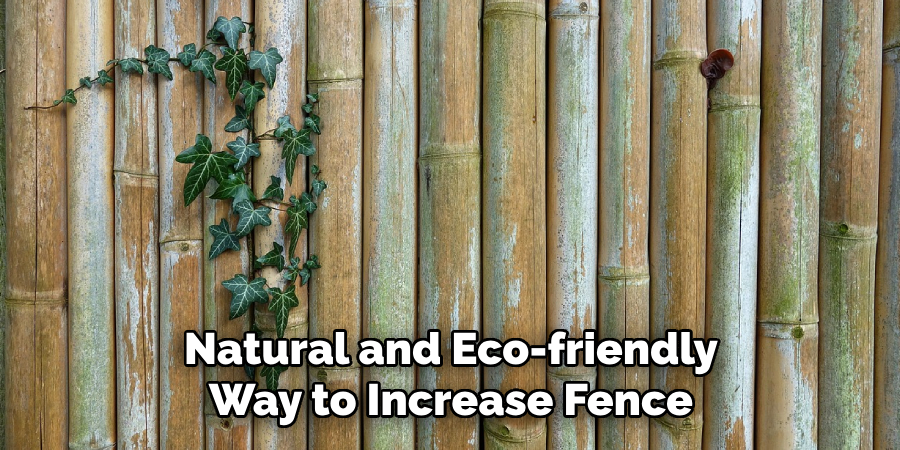
Aside from their functional benefits, bamboo and reed screens also add a touch of natural beauty to any outdoor space. They come in various styles and colors, allowing you to choose one that fits your aesthetic preference. Additionally, these screens can be easily maintained with occasional cleaning and treating with a sealant to prevent any color fading or weather damage.
Furthermore, bamboo and reed screens can also be used as standalone fencing solutions. They are easy to install and can be used to create boundaries in your backyard, garden or patio. These screens are also versatile and can be cut or trimmed to fit any specific size or shape needed.
7. Plant Tall Shrubs or Trees Along the Fence Line:
Landscaping can be a practical and aesthetically pleasing way to increase fence height. Planting tall shrubs or trees along the fence line not only adds greenery to your outdoor space but also acts as a natural barrier, deterring dogs from attempting to jump or climb. This is a cost-effective method compared to installing taller fencing. Additionally, trees and shrubs can provide shade and privacy for your backyard.
There are a variety of plant options to choose from when it comes to increasing fence height. Some popular choices include evergreens such as arborvitae or cypress, which retain their foliage year-round, providing continuous coverage. Trees like bamboo or birch can also serve as tall barriers, creating a more natural and visually appealing fence line.
8. Implement a Secondary Dog Fence:
Installing a secondary dog fence within the existing fence creates an additional layer of containment. This can be especially effective for smaller dogs or those with a tendency to dig. Ensure the secondary fence is securely anchored to prevent any gaps.
A secondary dog fence can provide an added level of security for your furry companion, giving you peace of mind and keeping them safe within the confines of your yard. While a primary fence may already be in place, adding a secondary fence can further reinforce boundaries and prevent escape attempts.
9. Build a Dog Run or Enclosure:
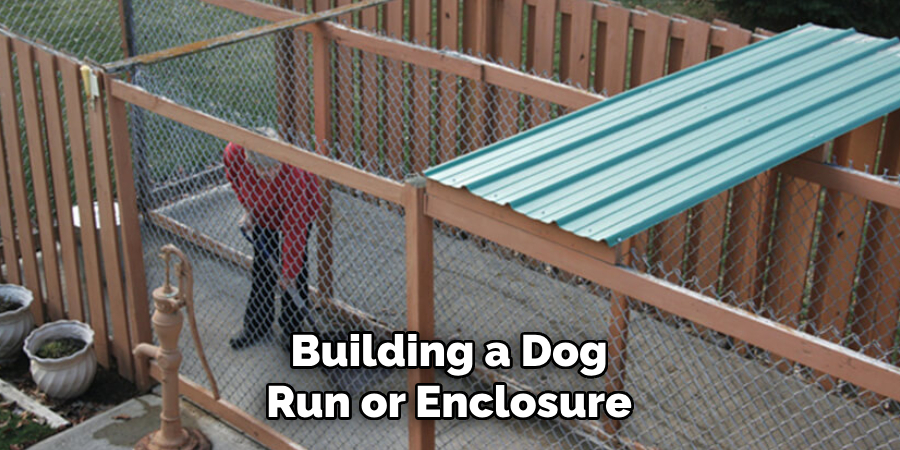
Building a dog run or enclosure provides a dedicated space for your furry friend to play, exercise, and enjoy the outdoors safely. Start by choosing a location in your yard that offers ample space, some shade, and protection from the elements. Ensure the chosen area is free from potential hazards like toxic plants or sharp objects.
For the enclosure, durable materials such as chain-link fencing or sturdy wooden panels are ideal. Remember to secure the fencing deep enough in the ground to prevent escape attempts by digging. Additionally, consider incorporating a sheltered area within the enclosure to offer your dog protection on sunny or rainy days, ensuring a comfortable environment year-round.
To add a bit of personal touch to the enclosure, consider adding some play elements such as a sturdy dog house or agility equipment. These additions will not only provide entertainment for your dog but also promote physical and mental stimulation.
Keep in mind that the size of the enclosure should be suitable for your dog’s breed and size. Smaller breeds may benefit from taller fences to prevent escape, while larger breeds may require more space to run and play.
10. Consult with a Professional Fence Builder:
When in doubt or dealing with unique challenges, consulting with a professional fence builder is a wise choice. A professional can assess your specific requirements, evaluate the existing fence, and recommend tailored solutions to make it taller for your dog.
In addition to providing expert advice, professional fence builders have the necessary skills and experience to properly install or modify a fence. This is especially important for larger or more complicated projects, where incorrect installation can lead to costly mistakes and potential safety hazards.
Conclusion
In conclusion, making a fence taller for dogs is a practical solution to enhance containment and ensure the safety of beloved pets. By carefully assessing the existing fence, selecting suitable extension methods, and implementing deterrents to prevent climbing or jumping, homeowners can create a secure environment for their dogs to roam freely.
It’s essential to prioritize safety and compliance with local regulations while considering the aesthetic and practical aspects of fence modifications.
Regular monitoring and testing are crucial to evaluate the effectiveness of the extended fence height and address any issues promptly. Hopefully, this article gave you some helpful tips about how to make fence taller for dog successfully, so now that you have the proper knowledge on how to get the job done, why not give it a try today?
About
Safety Fic is a distinguished figure in the world of Diy design, with a decade of expertise creating innovative and sustainable Diy solutions. His professional focus lies in merging traditional craftsmanship with modern manufacturing techniques, fostering designs that are both practical and environmentally conscious. As the author of diy, Safety Fic delves into the art and science of Safety Fic-making, inspiring artisans and industry professionals alike.
Education RMIT University
(Melbourne, Australia) Associate Degree in Design (Safety Fic) Focus on sustainable design, industry-driven projects, and practical craftsmanship. Gained hands-on experience with traditional and digital manufacturing tools, such as CAD and CNC software.
Nottingham Trent University
(United Kingdom) Bachelor’s in diyfastly.com and Product Design (Honors) Specialized in product design with a focus on blending creativity with production techniques. Participated in industry projects, working with companies like John Lewis and Vitsoe to gain real-world insights.
Publications and Impact
In diy, Safety Fic his insights on indoor design processes, materials, and strategies for efficient production. His writing bridges the gap between artisan knowledge and modern industry needs, making it a must-read for both budding designers and seasoned professionals.
